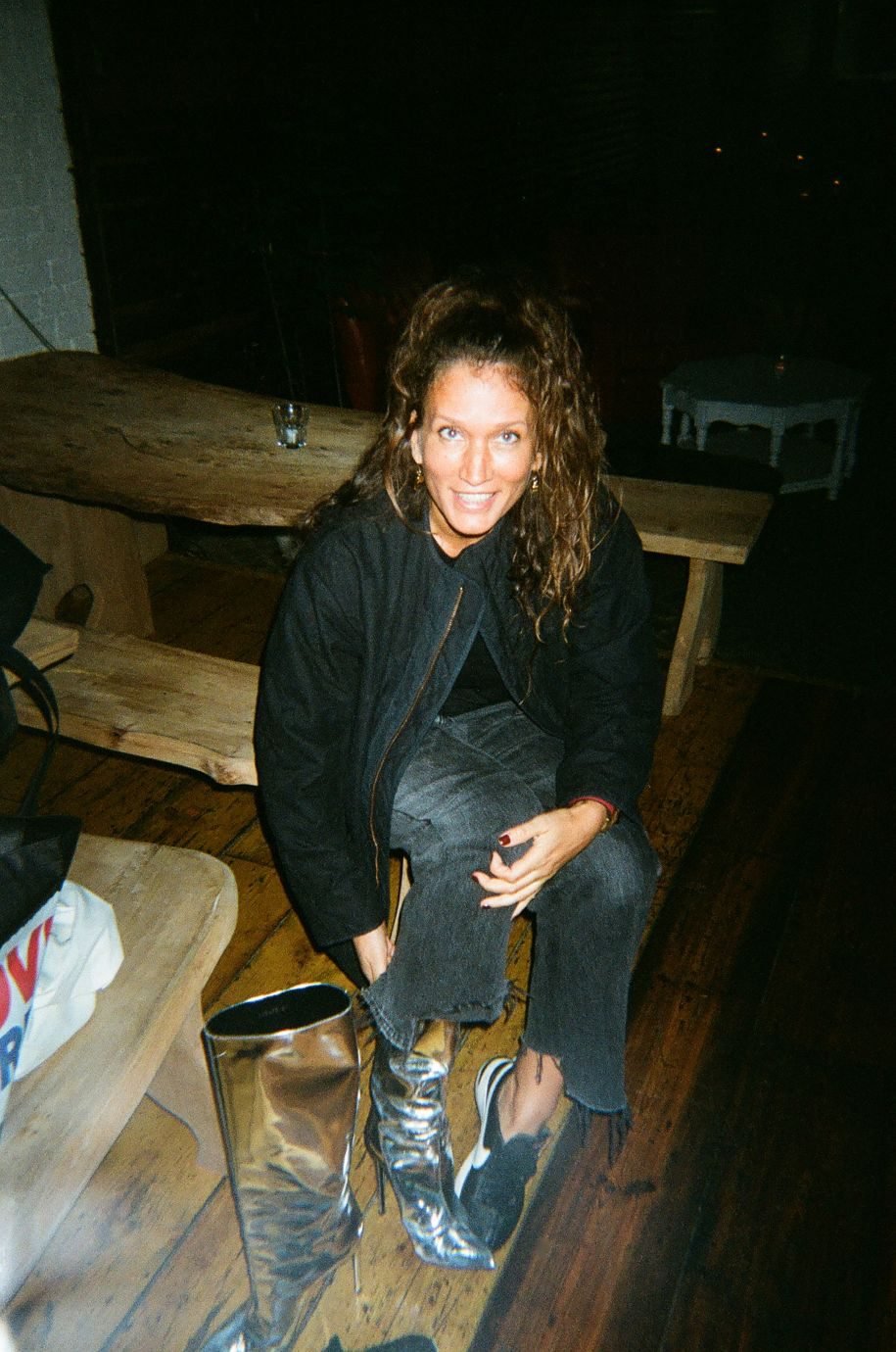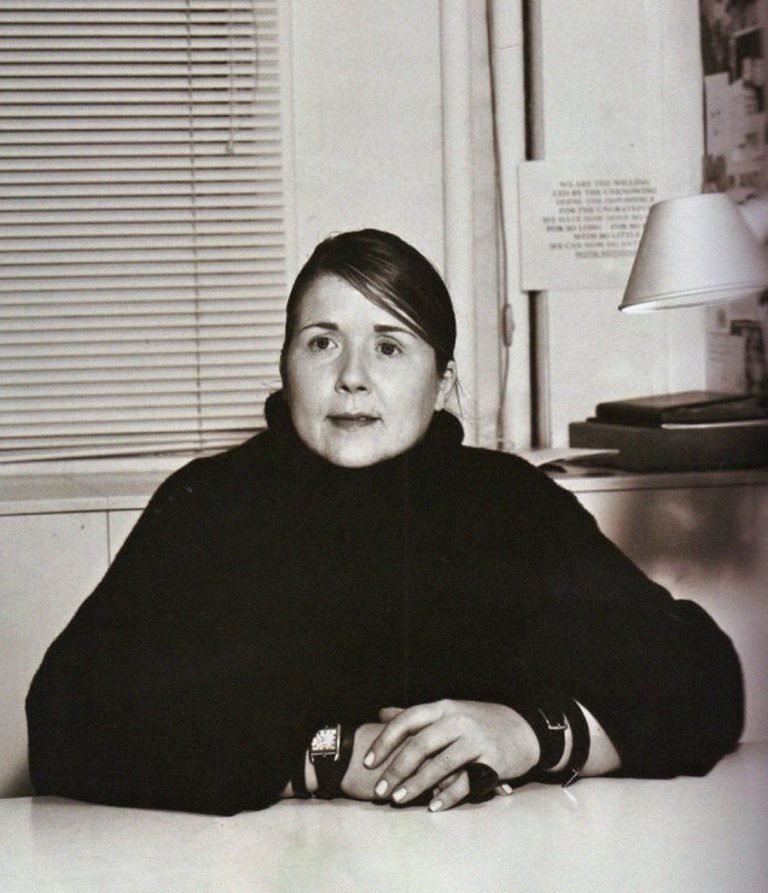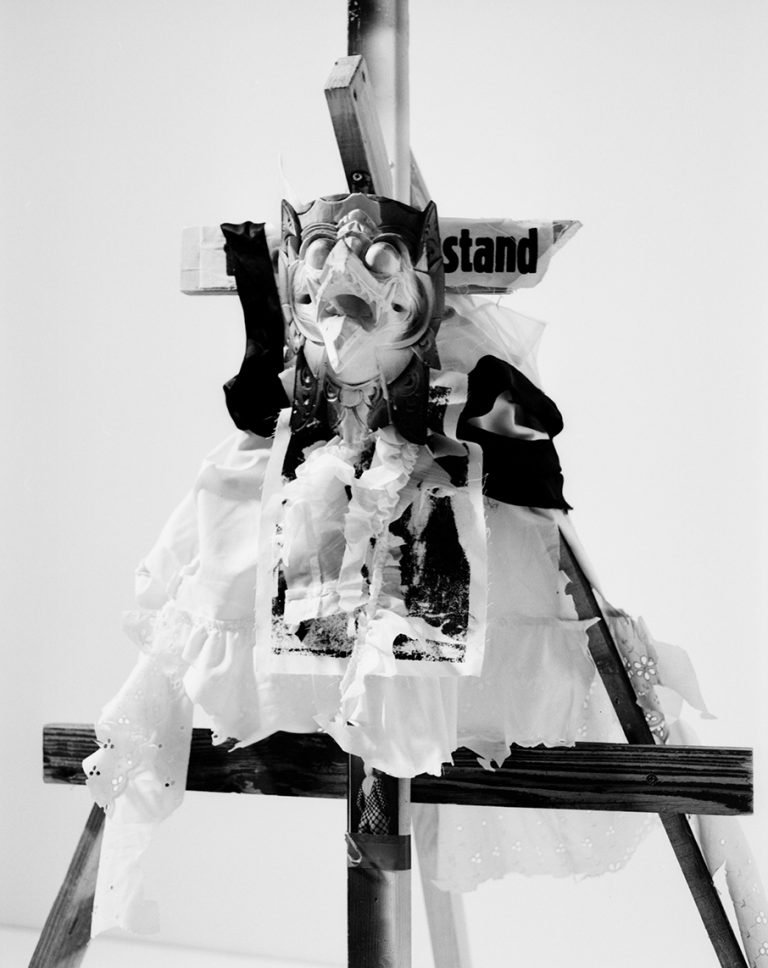On her childhood
“I was very, very fortunate to grow up in an environment that was very open to creativity.” Referring to growing up in her father John Rocha’s own design studio. “I was absolutely most comfortable when I was in his studio, learning to sew, just being around all these different types of people. He’s from Hong Kong but I grew up in Ireland, his pattern cutter was from Japan – there were all these different nationalities and fields.” The meld of Simone’s dual Irish and Chinese heritage is one of the most recognisable facets of her design identity. “Both my parents worked incredibly hard their whole life, so I spent a lot of time there.”
“I didn’t know I was going to do fashion, to be honest, I thought it would be a real cliché, that’s what my dad did, I couldn’t do that.” – Simone Rocha
On first applying to art school
“When I was in school I was a really bad student, I was dyslexic so I found it challenging. The only place I felt really good was in art class.” Seeing how she thrived in more practical subjects, she was inspired to go to art college and applied to the National College for Art and Design in Dublin. “I didn’t know I was going to do fashion, to be honest, I thought it would be a real cliché, that’s what my dad did, I couldn’t do that.” Instead, she decided to try out multiple creative outlets instead of specializing early. “There was a real mix of departments, painting was above fashion and then you had print on the floor below and then there was vis comm, and ceramics classes, everyone was sort of mixed together” But it wasn’t until Simone began working with textiles that she found a creative outlet which felt natural. “It felt really inspiring, translating something on a page to something physical through clothing. I did a project on the history of nurses, what they wore, the functionality.” Which would go on to become a signature design element of the Simone Rocha aesthetic.
“I don’t know if I’d be the designer I am today without Louise [Wilson], being around all these like-minded students. It completely changed my view on education, you can’t take that for granted you know.” – Simone Rocha
On studying under Louise Wilson
“There was no way I thought I was going to get in.” She confesses when asked about her thought when applying to the Fashion MA at Central Saint Martins over ten years ago, “I was still a little bit of a dosser at this point,” she added. “I was like, I’ll apply, but I won’t get in, I’ll take a year off – I got put on the waitlist initially then was given an interview, that’s when I met Louise for the first time, I was In complete awe,” she recounts. “I hadn’t had a huge amount of respect for authority before, but with Louise, I was so engaged, so in awe and scared of her but I wanted to impress her. So I was lucky I got accepted.”
“It’s honestly the best thing I ever did,” she says of the MA course. “I don’t know if I’d be the designer I am today without Louise, being around all these like-minded students. It completely changed my view on education, you can’t take that for granted you know.”
On debuting with Fashion East
“I’d done a collection for my MA that explored this idea of really stripped-back tailoring, I wanted to look at very classic men’s pieces and translate them into something feminine,” she said describing her graduate collection in 2010. “Then, you’re in this really weird position where you’re like what do I do now?” But before being discovered she wasn’t shy of adversity. “I went to a few places with my portfolio, one place went so badly, we were both like this is not going well.” She then explains how she decided to take some time out and see what happens, figure out how to find a job. That was until Simone got a call from Fashion East founder, Lulu Kennedy. “I’d just come from Ireland so I wasn’t familiar with Fashion East at the time, in my head, it was very bright and loud like the Henry Holland slogan t-shirts, so I was really surprised when she asked to meet me and asked me to be part of Fashion East. Lulu is so non-judgemental, it doesn’t matter where you come from she just really cares about the work, which was the same as I was raised. And for me, it was just such a privilege actually.”
On her female mentors
After working with Louise and Lulu, Simone again met another of fashion’s most prominent doyennes. “Rei Kawakubo came and saw my collection. She then came and saw it in Paris and that’s when Dover Street Market said we’d love to buy it, but we’re going to continue to organise meetings with Rei so she can see it. They did everything properly.” Rocha has been sold by Dover Street Market for 10 years now. “So that’s someone else who really saw what I did and supported me. So yeah, some really incredible people like Rei and her husband and her team as well.”
On finding her aesthetic
“This sounds so ridiculous, but it’s genuinely just like a part of me, the femininity that I identify with. Even if you look back at my BA collection or things I made when I was a kid it’s always been this aesthetic.” She says on her brand’s instantly recognisable look which Simone continues to hone and perfect with every collection. “But also how other people interact with these codes of femininity, balancing it with masculinity, translating it through fabrics, or embellishments; pearls, which are something like a signature to me. It’s literally like a train of thought,” she continues, looking back on her brand’s history. “I want to create work that makes people feel something and that comes from yourself. So the number one thing is to be comfortable with your identity. And for it to feel so natural that feels like a part of you.”
“The only thing that really annoys me is when reviews are really lazy and they just repeat what you’ve said.” – Simone Rocha
On criticism
“I don’t think you can take reviews and things like that personally.” It’s clear Simone Rocha puts a great deal of herself as a person into every piece and output of her eponymous brand. “The only thing that really annoys me is when reviews are really lazy and they just repeat what you’ve said, we don’t do big press releases and the show notes all come from me when I start a collection I write loads of ideas on paper,” she continues. “I always want people to see the show and to see how they feel about it. I think that’s part of our job and their job. I think… if it’s good it’s great, if it’s bad it’s terrible. But if things are bad then you need to hear it. I always think the criticism that is good for you it’s hard to swallow. Sometimes buyers won’t love a piece that you think is amazing. If you focus on that side too much it will just kill you as a designer.”
“It is important to understand that you’re not an artist, you’re a designer.” – Simone Rocha
On running a business
One thing many creatives struggle with is navigating the foreign elements of running a fashion brand which is at times a massive disconnect to the more creative aspects of design. “It’s not really talked about, especially when you’re studying,” she agrees, “It all stems down to experience, listening to people who actually have it, and being willing to accept that you can’t do everything. The way I do it is by looking at things in a really practical way. Another really important thing is understanding you’re not an artist, you’re a designer – it’s technically a trade, it used to be called the rag trade. And you need to find like-minded people who can identify with your identity but have different skills. I always talk about the jobs that aren’t as spoken about, everything from a production manager to visual merchandising, there are so many different elements that are integral parts in keeping a business moving. And I think you need to value that and know how necessary it is to own.”
On marketing yourself
“I was always really interested in photography,” she muses. Simone Rocha’s brand has rarely been seen in the form of big-bucks advertising, yet she has managed to curate a global base of loyal clients, fans, and collaborators. “Visuals were always something very important to me when I was doing my own brand, not everyone can be at the show, so I always want to capture and be able to share my work. We started doing print pieces when I opened my first shop, I wanted to offer something that people could take for free when they came into the shop. I’m inspired by so many amazing people, artists, friends, collaborators; I’ve been working with Jacob Lillis, the photographer, for nearly a decade. He documents everything I do so we just decided to share that. I was incredibly inspired by the artist Roni Horn for a collection so I asked if she would be willing to contribute to one of these printed matters. A lot of marketing comes from collaboration, and working with people in different mediums. You have their voice in your voice and you create this new conversation. And that’s really stimulating for me and the brand, and you realise that’s the part that resonated with other people, it’s this idea of having a conversation.”
On Motherhood
A mother of two, Simone Rocha had her first child nearly six years ago right in the midst of her rise to fame as a designer and became a mother for a second time earlier this year. “I love my work, it’s a big part of me, but I also love my family, and I feel very lucky to be able to bring that into my life. I thought of other female designers with children like Phoebe Philo. It can be done and the reality is that I’m an independent brand and it’s something that I am really proud of. It means you make your own decisions, your path is your own path. So it was something that I could make work, it was very tiring, but and absolutely worth it. You actually need those moments in time to also take a break. Having two children is very grounding and really takes the edge off you know?”
“I wanted to keep this independent model in my brand like Comme des Garçons or Rick Owens, and brands like that have a really strong identity, and a part of that is having their own stores.” – Simone Rocha
On opening her boutiques
Opening her first shop on London’s Mount Street in 2015 Simone has since opened two more in New York and Hong Kong respectively, which are all beautifully decorated with the same exquisite calibre as her clothing, accessories, and printed ephemera. “It’s something that I’m really proud of. I wanted to keep this independent model in my brand like Comme des Garçons or Rick Owens, and brands like that have a really strong identity, and a part of that is having their own stores.” With fashion’s mass shift towards e-commerce over recent years, Simone’s strong-willed love of showcasing her work through physical mediums is one of the main factors of her success as a brand. “I’ve been fortunate, enough to build my business actually selling clothes. A big part of that was opening my own store and being able to create a space where you can see the whole collection and the identity. I treat every collection and show as a little story, there are chapters and a balance in all the fabrics, it’s like they talk to each other. So it’s very hard to put that across out of context. Dover Street gave me my first shopping shelf and that was my first understanding of what it could be.”
On her collaborations
“I was really intrigued by the whole project because it was this new initiative where they really wanted this idea of a collective which I was really interested in.” She says on her work with the Moncler Genius project which was first launched at Milan Fashion Week in 2018. “I really like that Moncler is all about expertise, they are a down jacket company, here’s a product they do really well and then they were asking people like myself, Craig Green, Noir Kei Ninomiya, and Pierpaolo Piccoli to come in with our own identity. So to be a part of that was really exciting.”
Earlier this year Rocha went on to join the ranks of brands including Comme des Garçons, Lanvin, and Maison Margiela, launching a collection for Swedish fashion giant H&M. “I was really excited to do it, I remember the Marni collaboration from when I was at school, it was something I could access and felt like I owned part of the brand.” Her collection, which featured classic Simone Rocha faire; dreamy dresses, pearl-encrusted headbands, and feather-trimmed sandals at a more affordable price point sold out in a flash. “We wanted to take pieces from past seasons that if people bought Simone Rocha, they felt like they might have missed out, or they if didn’t have it they could access it. But I wanted to do it to everybody; women, and men, and kids. It was a huge undertaking because we were also doing it during the pandemic.” The collection was released when most countries’ H&M stores were closed, which not only lead to frantic laptop usage on the launch day but also saw her foray into new realms of marketing including printed averts and Piccadilly Circus’ giant billboards. It was a big learning curve for me and H&M. But it was an absolute privilege actually.”
“I don’t even feel established, I still feel like a younger designer.” – Simone Rocha
On overcoming barriers
When reading about Simone Rocha’s journey you wouldn’t be wrong to assume she’s continuously flown from strength to strength as a designer but becoming an established name doesn’t come without its difficulties. “I don’t even feel established, I still feel like a younger designer, but then you look back at your work and you go ‘Wow, that is amazing.’ 10 years fly because you’re so busy, navigating and learning all day. Finding the right team, getting your work in stores, staying in there, there’s a huge up and down,” she explains. “I think that’s a big thing to make sure that you’re aware that you are of a certain time, there are so many different generations working today and that that comes with lots of different challenges, as well. Respecting your contemporaries and predecessors, but then at the same time respecting the new guard, and being comfortable in that.”
“I’ve never had a business plan, every season after the show, I just think about the next show straightaway.” – Simone Rocha
On the future
But what’s in store for the next ten years of Rocha’s glittering career and legacy? “I’ve never had a business plan, every season after the show, I just think about the next show straightaway, about what can make that I’m interested in and that other people will feel part of. The more people who wear the collections, and the more people that get to come into the stores, or if I open new ones or if I collaborate with someone new the more amazing it is. That’s what I’m always interested in, all those new conversations which lead to a better business and a bigger team, that’s what pushes me forward day to day.”









